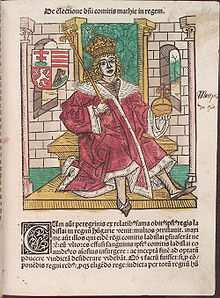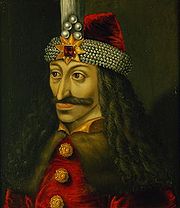
Stephen V Báthory
Encyclopedia

Hungary
Hungary , officially the Republic of Hungary , is a landlocked country in Central Europe. It is situated in the Carpathian Basin and is bordered by Slovakia to the north, Ukraine and Romania to the east, Serbia and Croatia to the south, Slovenia to the southwest and Austria to the west. The...
and after the king's death sided with Vladislav Jagiellon of Bohemia
Vladislaus II of Bohemia and Hungary
Vladislaus II, also known as Ladislaus Jagiellon ; was King of Bohemia from 1471 and King of Hungary from 1490 until his death in 1516...
and later together with Pál Kinizsi
Pál Kinizsi
Pál Kinizsi was a Hungarian general, legendary commoner commander in the army of king Matthias Corvinus. He was Comes of Temes since 1484 and Captain General of the Lower Parts of the Kingdom of Hungary...
defeated Prince John Corvin in the Battle of Csonthegy (1493). As a result of his cruelty in Transylvania
Transylvania
Transylvania is a historical region in the central part of Romania. Bounded on the east and south by the Carpathian mountain range, historical Transylvania extended in the west to the Apuseni Mountains; however, the term sometimes encompasses not only Transylvania proper, but also the historical...
, especially against the Székelys, he was deposed by the King in 1493 and died shortly afterwards.
Family history

Gutkeled
right|thumb|The coat-of-arms of the Hungarian Gutkeled clanThe Gutkeled was a family or clan of Hungarian nobles, to which a number of Hungarian noble families owe their ancestry....
, of the Ecsed
Ecsed
Ecsed is a small village in Hungary. There is an old town of Ecsed in the eastern part of Hungary that has been renamed Nagyecsed, meaning "grand" or "great Ecsed"....
branch. The name Báthory and the family coat-of-arms were granted in 1325.
Career
In 1467, he took part in Matthias' bitter defeat against Moldavia at the Battle of BaiaBattle of Baia
The Battle of Baia was fought on 15 December 1467 between the Moldavian Prince, Stephen the Great and Hungarian King, Matthias Corvinus. The battle was the last Hungarian attempt to subdue the independent Moldavia, as previous attempts had ended in failure...
. In 1476, Corvinus decided to support Vlad III Dracula in reclaiming his Wallachia
Wallachia
Wallachia or Walachia is a historical and geographical region of Romania. It is situated north of the Danube and south of the Southern Carpathians...
n throne from Basarab Laiotă. He therefore made Báthory supreme commander over an army of 8,000 infantry and 13,000 cavalry, but since Báthory was rather inexperienced in military leadership, "the actual leadership was shared by Dracula and the Serbian
Serbs
The Serbs are a South Slavic ethnic group of the Balkans and southern Central Europe. Serbs are located mainly in Serbia, Montenegro and Bosnia and Herzegovina, and form a sizable minority in Croatia, the Republic of Macedonia and Slovenia. Likewise, Serbs are an officially recognized minority in...
despot Vuk Brancovic. Before this, Dracula and Báthory had waged war in Bosnia
Bosnia (region)
Bosnia is a eponomous region of Bosnia and Herzegovina. It lies mainly in the Dinaric Alps, ranging to the southern borders of the Pannonian plain, with the rivers Sava and Drina marking its northern and eastern borders. The other eponomous region, the southern, other half of the country is...
, where Báthory was sent by Corvinus to free a certain Bosnian king whose name was also Matthias. The new campaign would involve Hungarian, Moldavia
Moldavia
Moldavia is a geographic and historical region and former principality in Eastern Europe, corresponding to the territory between the Eastern Carpathians and the Dniester river...
n, and Wallachian troops, with the assistance of a small Serbian contingent. Dracula wrote to his cousin, Prince Stephen III of Moldavia
Stephen III of Moldavia
Stephen III of Moldavia was Prince of Moldavia between 1457 and 1504 and the most prominent representative of the House of Mușat.During his reign, he strengthened Moldavia and maintained its independence against the ambitions of Hungary, Poland, and the...
, to wait for him so that the two could merge their armies, but the merging failed due to delayment in movement of the Hungarian troops, which resulted in Stephen's defeat at the Battle of Valea Albă
Battle of Valea Alba
The Battle of Valea Albă or Battle of Războieni or Battle of Akdere was an important event in the medieval history of Moldavia. It took place at Războieni, also known as Valea Albă, on July 26, 1476, between the Moldavian army of Ştefan cel Mare and an invading Ottoman army which was commanded...
on July 26, 1476. On August 18, the two armies merged and helped Stephen get rid of the Turks in Moldavia. After a consultation that took place in the city of Braşov
Brasov
Brașov is a city in Romania and the capital of Brașov County.According to the last Romanian census, from 2002, there were 284,596 people living within the city of Brașov, making it the 8th most populated city in Romania....
, Dracula, Báthory, and Brancovic invaded Wallachia from southern Transylvania with an army of 35,000, whereas Stephen would aid them by attacking eastern Wallachia with 15,000 men. Dracula's offensive began in early November 1476 and defeated Laiotă's 18,000 strong army at Rucăr
Rucar
Rucăr is a commune in the north-eastern part of Argeş County, Romania. At the 2002 census, the population of the commune was 6,207. It is composed of two villages, Rucăr and Sătic....
, at the Wallachian-Transylvanian border. Both armies lost around 10,000 men.

Târgoviste
Târgoviște is a city in the Dâmbovița county of Romania. It is situated on the right bank of the Ialomiţa River. , it had an estimated population of 89,000. One village, Priseaca, is administered by the city.-Name:...
where he met with Stephen. The two swore eternal allegiance to one another and when at the presence of Báthory, the two pledged as well to pursue a great crusade against the Turks. By November 11, Báthory reported to the town officials of Sibiu
Sibiu
Sibiu is a city in Transylvania, Romania with a population of 154,548. Located some 282 km north-west of Bucharest, the city straddles the Cibin River, a tributary of the river Olt...
that most of Wallachia was in Dracula's hands and added that "all the boyar
Boyar
A boyar, or bolyar , was a member of the highest rank of the feudal Moscovian, Kievan Rus'ian, Bulgarian, Wallachian, and Moldavian aristocracies, second only to the ruling princes , from the 10th century through the 17th century....
s aside from two are with us" and "even the latter will soon join us."
On November 16, Bucharest
Bucharest
Bucharest is the capital municipality, cultural, industrial, and financial centre of Romania. It is the largest city in Romania, located in the southeast of the country, at , and lies on the banks of the Dâmbovița River....
fell to Báthory's army and on November 26, Dracula was reestablished as Prince of Wallachia for his third time. After Stephen and Báthory retreated from Wallachia, Laiotă would return to Wallachia with an army to reclaim his throne. In December, the two would meet each other in battle. Dracula possessed only a small army and was killed in battle.
Battle of Bread Field
In 1479, Báthory was made governor of Transylvania and in late August 1479, an Ottoman expedition from Bosnia, commanded by twelve pashaPasha
Pasha or pascha, formerly bashaw, was a high rank in the Ottoman Empire political system, typically granted to governors, generals and dignitaries. As an honorary title, Pasha, in one of its various ranks, is equivalent to the British title of Lord, and was also one of the highest titles in...
s, invaded Transylvania with a force of 43,000 men. The Turks moved very quickly through the land while pillaging it, giving Báthory little time to gather his militia at Sibiu. Pál Kinizsi
Pál Kinizsi
Pál Kinizsi was a Hungarian general, legendary commoner commander in the army of king Matthias Corvinus. He was Comes of Temes since 1484 and Captain General of the Lower Parts of the Kingdom of Hungary...
, the Ban
Ban (title)
Ban was a title used in several states in central and south-eastern Europe between the 7th century and the 20th century.-Etymology:The word ban has entered the English language probably as a borrowing from South Slavic ban, meaning "lord, master; ruler". The Slavic word is probably borrowed from...
of Timişoara
Timisoara
Timișoara is the capital city of Timiș County, in western Romania. One of the largest Romanian cities, with an estimated population of 311,586 inhabitants , and considered the informal capital city of the historical region of Banat, Timișoara is the main social, economic and cultural center in the...
, promised to aid Báthory. As Báthory approached Sebeş
Sebes
Sebeș is a city in Alba County, central Romania, southern Transylvania.-Geography:The city lies on the Mureș River valley and it straddles the Sebeș river...
, Ali Bey, one of the Turkish pashas, had raised camp on a plain between Mureş
Mures
The name Mureș may refer to:*Mureș County in Romania*Mureș River in Romania and Hungary *Mures , a puzzle gameAlso, the following localities contain the name Mureș and lie on the banks of the river above....
and Sebeş, totally unaware that Kinizsi was also on his way against him.
On the early morning of October 13, Báthory appeared on the "heights beyond the brook." Ali was forced to stand ground in order to secure an eventual redrawl and evacuate his booty." Báthory ordered his army to prepare for battle: his 3,000 Transylvanian Saxons
Transylvanian Saxons
The Transylvanian Saxons are a people of German ethnicity who settled in Transylvania from the 12th century onwards.The colonization of Transylvania by Germans was begun by King Géza II of Hungary . For decades, the main task of the German settlers was to defend the southeastern border of the...
, supported by a second line of Transylvanian Wallachians, comprised the right flank on the Mureş River
Mures River
The Mureș is an approximately 761 km long river in Eastern Europe. It originates in the Hășmașu Mare Range in the Eastern Carpathian Mountains, Romania, and joins the Tisza river at Szeged in southeastern Hungary....
, while the Hungarians comprised the left flank—he and his heavy cavalry were placed in the middle. The Ottoman leaders were in disagreement and had their preparations for the battle delayed; after "three hours of idle waiting, Báthory, confident that Pál Kinizsi would arrive any minute, gave the order to attack." The Transylvanian Saxons opened the attack, but were routed; the Transylvanian Wallachians followed their fate, with many being wounded or killed; and later, the Hungarian line would be pressured to retreat to the centre. Báthory then charged with his heavy cavalry, but fell off his horse; this alerted his companions who interpreted it as a bad omen and advised him to either turn back or retreat to the mountains. He ignored their advice and as head of his cavalry, charged the first Ottoman line with a great force, routing them. Ali then charged with his cavalry and a fierce battle took place that lasted for three hours. Báthory was seriously injured, as he bled from six wounds; "his horse had been killed under him." Surrounded by a "wall of corpses" and barely holding onto his life, he was about to lose the battle when Kinizsi's army appeared on the hill, with drums and trumpets making their noise. Some 900 Serbs under a Demeter Jakšić assisted by "numerous courtiers of the king", charged against the Turks. The Turks, who were taken by surprise, were slaughtered by the furious Kinizsi and after a renewed attack, he managed to save Báthory.
The few Turks who survived the massacre fled into the mountains, where the majority were killed by the local population. Ali, who spoke Romanian
Romanian language
Romanian Romanian Romanian (or Daco-Romanian; obsolete spellings Rumanian, Roumanian; self-designation: română, limba română ("the Romanian language") or românește (lit. "in Romanian") is a Romance language spoken by around 24 to 28 million people, primarily in Romania and Moldova...
put on some peasant clothes and fled to Wallachia
Wallachia
Wallachia or Walachia is a historical and geographical region of Romania. It is situated north of the Danube and south of the Southern Carpathians...
. Some 30,000 Turks died in the battle, whereas Báthory lost 8,000 Hungarians and some 2,000 Transylvanian Saxons and Transylvanian Wallachians. The two commanders feasted together with their troops, with Kinizsi dancing with a dead Turk as his companion.
Aftermath
Báthory was accused of using excessive cruelty against the Székely in Transylvania and was disposed by Vladislaus IIVladislaus II of Bohemia and Hungary
Vladislaus II, also known as Ladislaus Jagiellon ; was King of Bohemia from 1471 and King of Hungary from 1490 until his death in 1516...
in 1493. He died shortly afterwards. His family
Báthory
The Báthory were a Hungarian noble family of the Gutkeled clan. The family rose to significant influence in Central Europe during the late Middle Ages, holding high military, administrative and ecclesiastical positions in the Kingdom of Hungary...
would return to rule as Voivods and then Princes of Transylvania.

